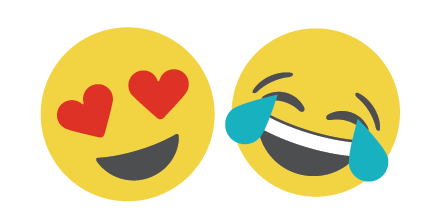As the online world swells with information and people’s attention spans shrink, the minimalist approach to communication is becoming more prevalent. People have willingly traded in long-form journalism for digestible listicles, “snail mail” letters for text messages, and now words for pictures (i.e., emojis).
According to HubSpot, the little yellow faces got their start in Japan in 1999. They were imported to the United States by piggybacking on the IOS5 update in 2011, and in that same year became super ![]() . As users began discovering different ways to use them, emojis became ubiquitous across many different cultures, languages, and age groups.
. As users began discovering different ways to use them, emojis became ubiquitous across many different cultures, languages, and age groups.
As we know, any shift in communication—whether it’s letters to telegrams, telegrams to telephone calls, or calls to texts and emails—cultivates new marketing opportunities, and the emoji revolution has been no different. This method of universal, language-transcending communication has spawned a growing industry of advertisers whose goal is to project their brand image, personality, and marketing messages with the help of these playful, representative symbols, oftentimes boiling down paragraphs of copy into a single symbol that represents a feeling, place, thing, or even brand identity. While some companies continue to incorporate traditional emojis into their online communication, other brands are reinventing emojis themselves.
5 Examples of Great Emoji Marketing
- Coke: Enhancing its reputation as a cutting-edge brand, Coke can claim fame as the first branded emoji to grace Twitter. If users tweet using #ShareACoke, the iconic bottles appear.

Via Tech Crunch/Twitter
- Chevrolet: The new #ChevyGoesEmoji campaign proves emojis can be impactful beyond digital/online marketing as a component of a fully integrated storytelling campaign.

Via Chevrolet
- Star Wars/Disney: Rather than using standard emojis to promote Star Wars: The Force Awakens, the film powerhouse created its own app that allows users to access over 50 branded emojis.

Via CNET
- World Wildlife Fund (WWF): To celebrate Endangered Species Day, WWF launched the #EndangeredEmoji campaign that connected 17 emoji animals to their real-life, endangered counterparts, such as the Asian elephant or Sumatran tiger. For each tweet that consumers posted using the hashtag and emojis, WWF asked for a donation of 10 cents.

Via Slate
- Domino’s Pizza: In what is one of the most prominent emoji marketing tactics to date, people went crazy over the Domino’s Pizza application that allows users to place an order by simply texting the pizza emoji to the company.
How the  can be the
can be the  to your patients’
to your patients’ 
To make a quick, but lasting, impression, the service emojis provide is probably more significant than you think. First, they are an intuitive way to connect on an emotional level with your consumers. A simple smile goes a long way, and if you’re not physically there to share yours, an applicable emoji is a great substitute.
Second, using emojis can make an ad feel less invasive because it adds context to your tone and expression, especially when the message pertains to personal healthcare matters. Emojis make your brand appear more humanized, and many consumers feel more comfortable and connected when the message seems genuine versus commercial.
And finally, for brands looking to form strong connections with their audience, emojis encourage interaction and conversation across text-based communication (such as social media) to engage deeper with your consumers and learn about their experiences, stories, and sentiment towards your brand.
On the flip side, with any shiny, new marketing tactic, it’s important to tread lightly. Don’t use emojis just for the sake of using emojis. Doing too much can appear cutesy or satirical, which can backfire in an industry (like healthcare) with a generally serious tone. Also, using emojis incorrectly can misrepresent your brand or come off unintentionally offensive. Regardless of the marketing tools at your disposal, always choose those that align with your business and marketing goals, and select strategies that fit with who you are as a brand.
Conclusion
If you are an emoji fan, and think they could make an impact in your healthcare marketing plan, Momentology has a few great things to think about before you get started. Like any campaign tool, it is important to first understand how emojis can help tell your brand story and how they will support your objectives by adding value to your advertising. That’s where we come in. We understand where it all began, and take pride in our strategic approach to identifying unique marketing opportunities and aligning those with your goals. Want in on the action? Give us a call.
Emma Greifenkamp
Latest posts by Emma Greifenkamp (see all)
- Google Changes Ads Policy as Healthcare Advertisers Scramble to Adapt - December 11, 2019
- The Insighter: Keeping the Eyes on Your Prize - May 25, 2018
- Social Media Week Chicago: Let’s Talk About It! - December 8, 2017
- Our Top Takeaways from Salesforce World Tour Chicago - September 6, 2017
- 5 Key Digital Marketing Trends in Healthcare - February 22, 2017




